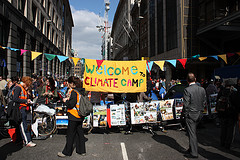 The urban Climate Camp at Bishopsgate by the European Climate Exchange has been reported to have over 2000 people and 150 tents, and has been described as a hugely impressive infrastructure. There has been numerous theatrical performances, and sound-systems alongside compost toilets, a medical tent, a children’s area, a couple of working kitchens, speakers, banners across the street and numerous workshops. Many people have been picnicking there and the camp has been attracting passers by and city workers. There have been police lines on either side of the camp but people are allowed in and out. There has been dancing near the police lines and the atmosphere has generally been described as very good, with office workers waiving out of windows at the campers.
The urban Climate Camp at Bishopsgate by the European Climate Exchange has been reported to have over 2000 people and 150 tents, and has been described as a hugely impressive infrastructure. There has been numerous theatrical performances, and sound-systems alongside compost toilets, a medical tent, a children’s area, a couple of working kitchens, speakers, banners across the street and numerous workshops. Many people have been picnicking there and the camp has been attracting passers by and city workers. There have been police lines on either side of the camp but people are allowed in and out. There has been dancing near the police lines and the atmosphere has generally been described as very good, with office workers waiving out of windows at the campers.
—
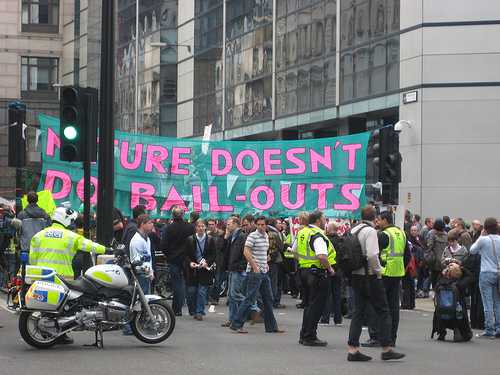
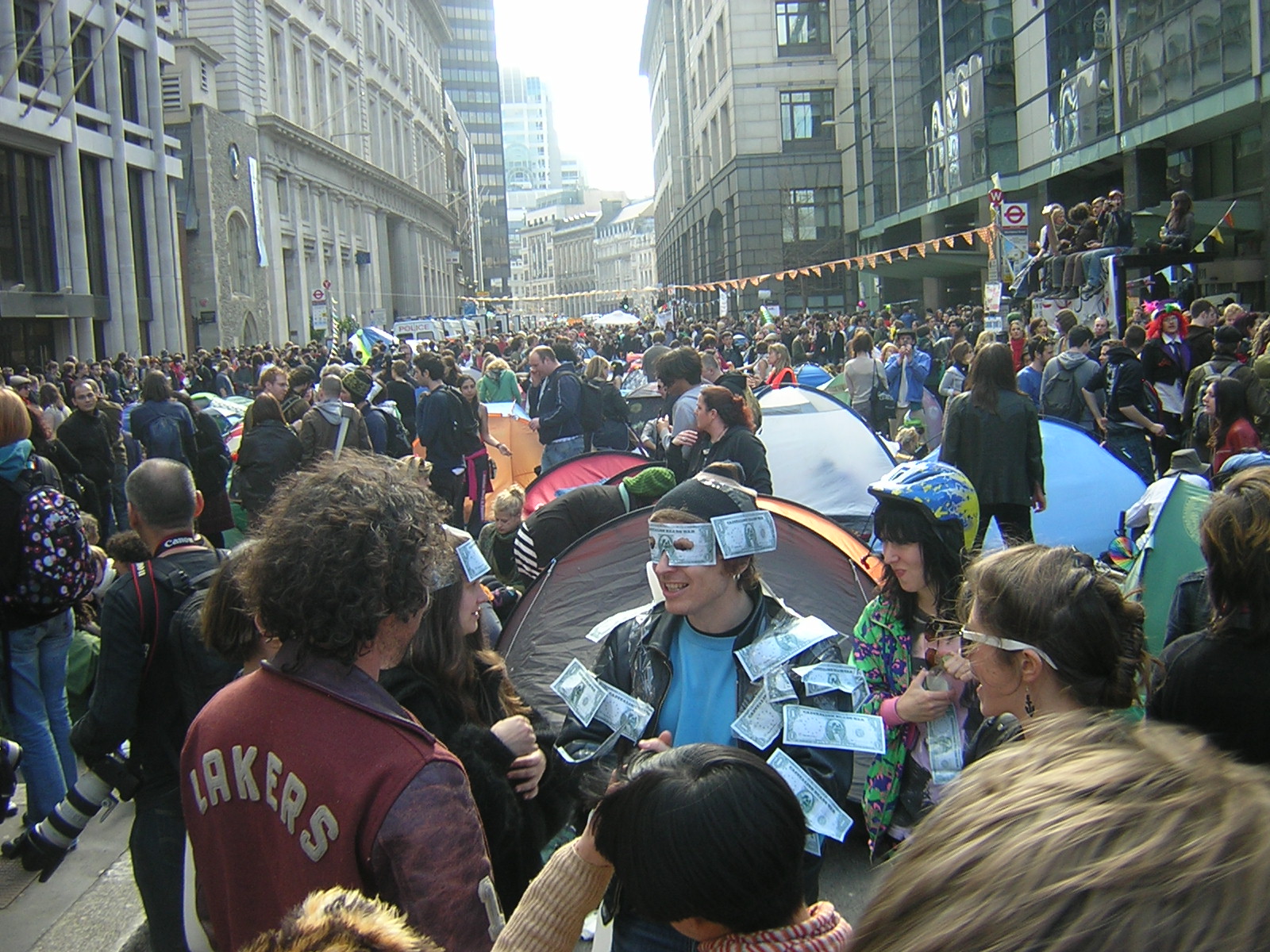
“Street empty. They beat us out and squashed our tents. But oh what a world we created! Shame on the powers that be.”
– Climate Camp London
Climate Camp in the City has come to a end as police aggressively cleared protesters from Bishopsgate. Several hours earlier campers agreed to move to the North to shore up their defences, but after heavily provocative policing, people began to try and leave.
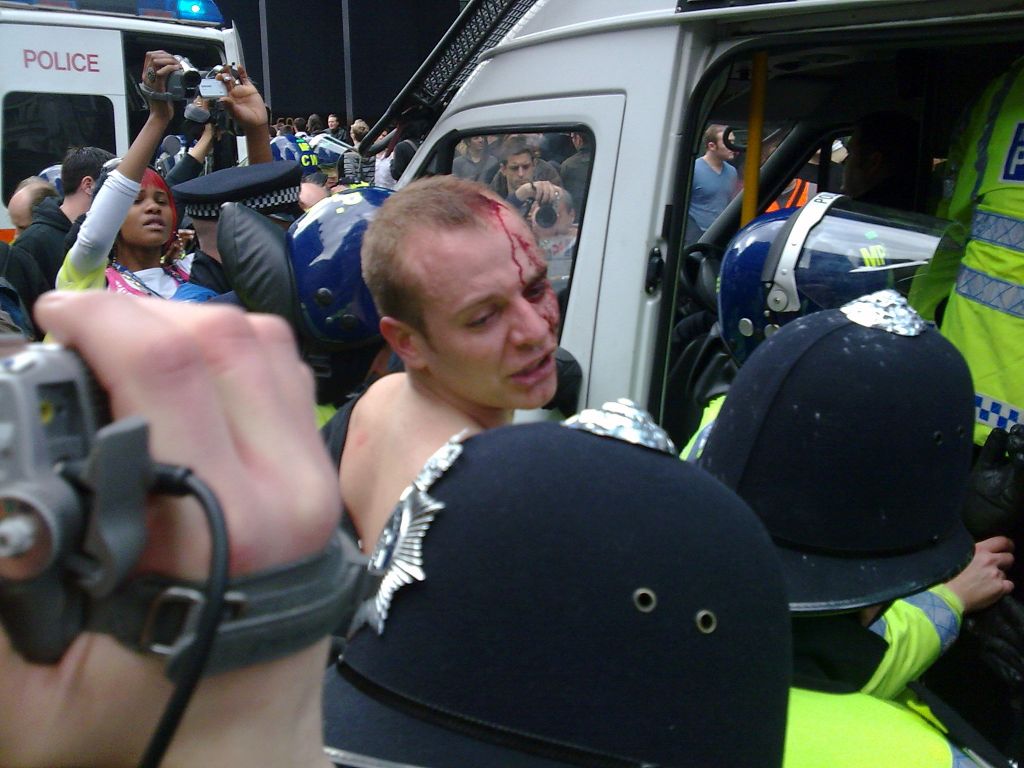 Many campers head home with light injuries after a long evening of intimidation and violence from the police. At several points they moved in to snatch individuals from the crowd and sent lines of officers into sitting campers, unprovoked. One protester said “the police acted aggressively, goading protesters, but we remained peaceful and the aim remains strong.” By 2am their aggressive tactics succeeded with most of the campers doing their best to escape the cordon. Soon after the camp was broken.
Many campers head home with light injuries after a long evening of intimidation and violence from the police. At several points they moved in to snatch individuals from the crowd and sent lines of officers into sitting campers, unprovoked. One protester said “the police acted aggressively, goading protesters, but we remained peaceful and the aim remains strong.” By 2am their aggressive tactics succeeded with most of the campers doing their best to escape the cordon. Soon after the camp was broken.
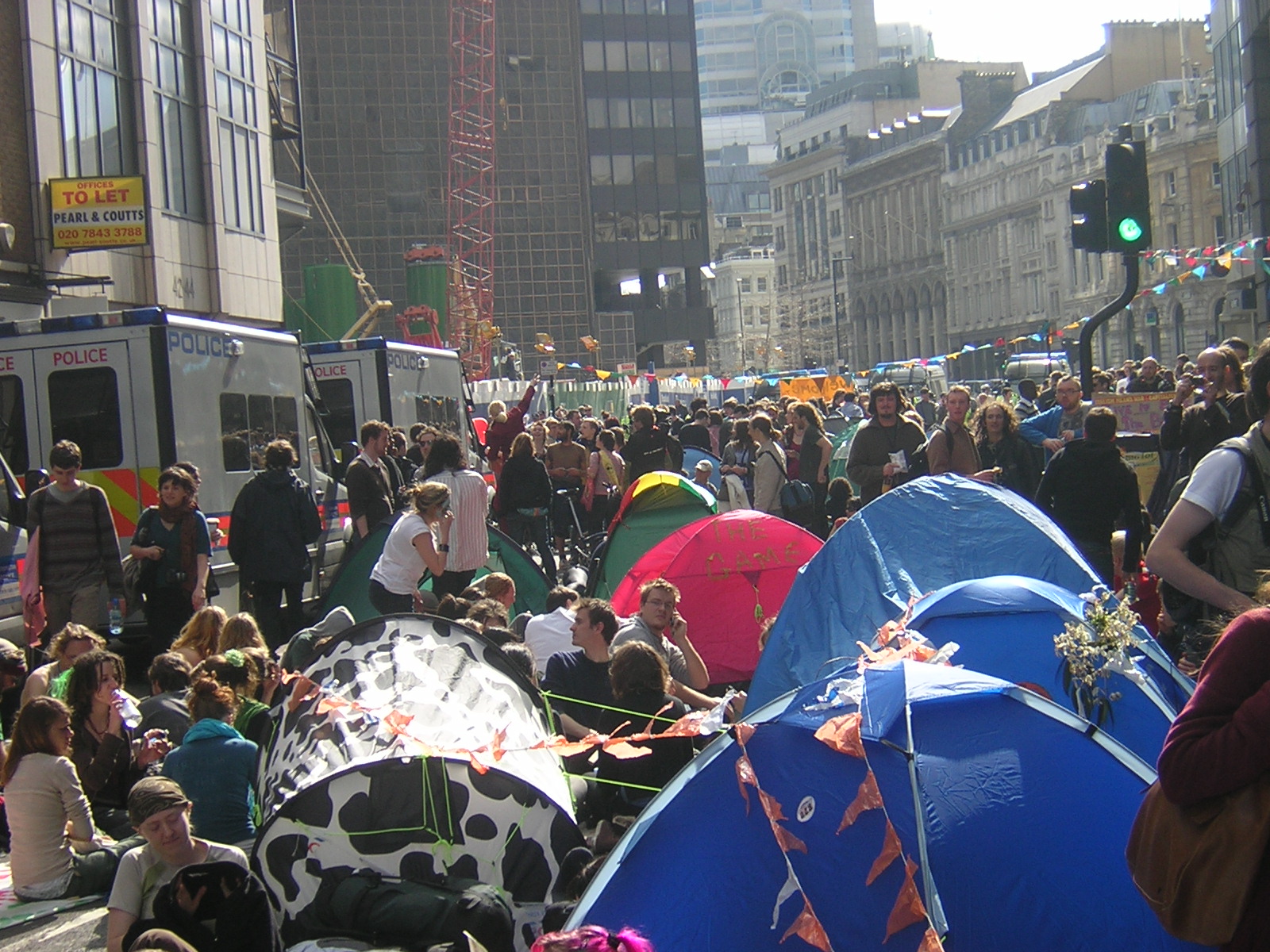 Campers claim a victory having held their ground peacefully for so long, serving food, drink, a variety of workshops to the campers, and above all, creating a positive space for change. We also pay homage to the inventor of the pop-up tent, for making today possible.
Campers claim a victory having held their ground peacefully for so long, serving food, drink, a variety of workshops to the campers, and above all, creating a positive space for change. We also pay homage to the inventor of the pop-up tent, for making today possible.
Updates:
01:20 Reports that Climate Camp has been evicted by police – people pushed back and beaten, wondering how to retrieve their belongings.
01:10 – Police pulling people out of Climate Camp from southern perimeter.
00:30 – Climate Camp participants have been making speeches to the police about why they have been taking action today.
00:20 – Reports from Climate Camp of police using bolt-cutters to dismantle the bike barricade whilst there is now nothing to stop them coming in from the North.
23:55 – Police are now moving from south to north pushing people out of the space occupied by the climate camp, and it’s clearing out fast. About 500 people are left at this point.
23:28 – Push past Liverpool Street as a group are chased at speed pursued by police dogs and vans. At least one arrest.
23:18 – Letting people out from South side opposite Liverpool St. Lots of police charging, Bottles being thrown from outside camp towards charging cops
22:48 – About 2000 people in Climate Camp Kettle, police want to impose a section 14 and ID everyone. They’re looking to force people out through the North two at a time. There are police massing at the South End, Due to the amount of campers that does currently not seem feasible.
22:15 – riot police have moved into the climate camp crowd at bishopsgate and are violently dragging peaceful sitting protesters to disperse the area
earlier this evening riot police forced their way into the peaceful climate camp. protesters held their hands up and shouted ‘this is not a riot’ over and over, while fully-kitted riot police used shields and batons to push and violently surge forward into the camp along the eastern pavement of bishopsgate. it seems likely this clearance operation had been planned all day – a line of police vans parked along the eastside had created a ‘walkway’ along that pavement which was effectively separated from the camp itself. all the riot police had to do was push their way onto that side, and it is clear that was their strategy. once done, there was a further stand-off for a while before the next stage to start moving protesters out one-by-one.
21:35 – we are current receiving reports from the Climate Camp in the city, that all people are going to be searched to be allowed out, as well as people are told to delete photos of officers from their cameras, under the threat of seizure. Interestingly the joint committee on human rights of the UK parliament has just made a couple of recommendation about policing directly condemning the use of these anti-terror power to police protest. Here are the direct quotes and links.
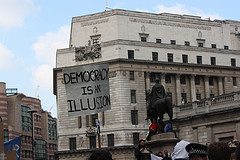 Recommendations of the UK Parliament Joint Committee on Human Rights concerning the use of anti-terror powers for stop-and-search:
Recommendations of the UK Parliament Joint Committee on Human Rights concerning the use of anti-terror powers for stop-and-search:
“93. Whilst we accept that there may be circumstances where the police reasonably believe, on the basis of intelligence, that a demonstration could be used to mask a terrorist attack or be a target of terrorism, we have heard of no examples of this issue arising in practice. We are concerned by the reports we have received of police using counter-terrorism powers on peaceful protesters. It is not clear to us whether this stems from a deliberate decision by the police to use a legal tool which they now have or if individual officers are exercising their discretion inappropriately. Whatever the reason, this is a matter of concern. We welcome the Minister’s comments that counter-terrorism legislation should not be used to deal with public order or protests. We also welcome the recommendation in the new guidance to human rights being included in community impact assessments. We recommend that the new guidance on the use of the section 44 stop and search power be amended to make clear that counter-terrorism powers should not be used against peaceful protesters. In addition, the guidance should make specific reference to the duty of police to act compatibly with human rights, including, for example, by specifying the human rights engaged by protest.”
http://www.publications.parliament.uk/pa/jt200809/jtselect/jtrights/47/4707.htm
Concerning the impact of the recent legislation about taking photographs of officers in public the joint committee said:
“94. Concerns have recently been expressed in the media that a new provision in the Counter Terrorism Act 2008 makes it a criminal offence to take and publish a photograph of a police officer. Section 76 of the 2008 Act makes it an offence to elicit or attempt to elicit information about an individual who is or has been a constable “which is of a kind likely to be useful to a person committing or preparing an act of terrorism.”[174] As the Explanatory Notes to the Counter Terrorism Bill correctly stated, the new offence will only be committed where the information in question is “such as to raise a reasonable suspicion that it was intended to be used to assist in the preparation or commission of an act of terrorism, and must be of a kind that was likely to provide practical assistant to a person committing or preparing an act of terrorism.”[175] That is the effect of a decision of the Court of Appeal in a case in 2008[176] interpreting the same statutory language in the separate terrorism offence of possessing a document or record containing information of a kind likely to be useful to a person committing or preparing an act of terrorism.[177]”
“95. We therefore do not share the concerns expressed in the media that the new offence criminalises taking photographs of the police. However, we do regard as significant the fact that this is being widely reported as a matter of concern to journalists. Legal uncertainty about the reach of criminal offences can have a chilling effect on the activities of journalists and protesters. We therefore recommend that, to eliminate any scope for doubt about the scope of the new offence in section76 of the Counter Terrorism Act 2008, guidance be issued to the police about the scope of the offence in light of the decision of the Court of Appeal, and specifically addressing concerns about its improper use to prevent photographing or filming police. ”
http://www.publications.parliament.uk/pa/jt200809/jtselect/jtrights/47/4707.htm
20:45 – currently kettled in but they are having a ceilidh/ barn dance so not broken yet! Fuck the po-lice.
18:35 – Riot police baton charge climate camp

Numerous reports come in stating the riot police are in the process of attacking the peaceful climate camp. Even in the face of severe and unprovoked police brutality the protesters are maintaining their peaceful protest.
Despite events throughout the day at the urban climate camp being entirely peaceful, riot police are mobilising at the camp with 14 riot vans pulling up in addition to the six already present there. While climate campers appealed to the police highlighting the peaceful nature of the protest and the presence of many families with children, the police stormed into into the camp through a gap in the bicycle perimeter of the camp indiscriminately attacking campers with batons, pushing families and children out of tents and destroying sections of the camp. Camomile, Bishopsgate and Womwood st are closed off hemming in the campers. Five police motor bikes pulled up with what looked like surveillance gear. Another report comes in from climate camp stating that the police have formed lines at the Liverpool st end of the camp. a third report comes in from an Indymedia volunteer reporting that he has ‘never seen anything like this’ three lines of helmeted riot police are indiscriminately beating protesters with batons. Protesters are not fighting back and are maintaining the non-violent nature of their action in spite of this there are reported to be at least four arrests. The crowd chants shame on you as the police continue to attack campers.
—
Full 1st April timeline
Video showing police tactics clearing space.
Camp setting-up video.
Panorama – click through to original for bigger image: 
—
Another personal report: I arrived at about 5pm, at the north end of it. Police were already forming a line alongside the barrier that had been erected made up of railings and bikes attached to them, but they were not blockading and every one was free to visit, come in and out.
There was a festive atmosphere, colourful tents, banners, street decoration…
A man with the slogan “God is too big for religion” on his t-shirt then started to try and make every single riot policeman and woman on the line to smile. “This is an order”, he shouted, “and if they don’t comply, things will only get worse”. He managed to get or steal a smile of every single police officer including a police woman who tried just too hard to keep a stony face.
He then proceeded to try and hug every one “of these very wonderful people” as a sign of his love. To try to get to their hearts, he asked them if they had children: “please raise your hands if you do not have children, or keep your hands down if you do have children”. None of the police moved their arms but he did not succeed to hug every one of the officers. One of them claimed that he was embarrassing them.
I then proceeded to photograph the rest of the camp. A few police vans had somehow made their way into the middle of the climate camp.
At about 6.15pm the south end of the camp started to get “nasty”. Police charged into the peaceful people, bringing tents violently down to the ground, but people managed to peacefully stop the police violence, and a party was established in front of the police lines.
A few police also moved to the middle of the camp, next to the vans, and it looked like they were trying to divide the crowd. But people kept the area occupied and this didn’t happen.
As it got darker, more and more riot police and vans gathered at the south end of the camp, and I heard that a demonstration had formed at the north end of the camp, but that the police were afraid of the growing numbers and were preventing people from getting in or out of the camp. We had been cordoned off without warning.
Three meetings were held in the camp. One at the south end, another at the north end, and another one in the middle, right in front of police. We were informed that the police had decided to keep us penned for two hours, and that after that, they would allow us out in groups of 20, after taking every one’s photograph and details.
Some people considered sleeping the night in the camp, but it was clear from the beginning of the night that police were going to disrupt people’s sleep all through the night, just like it had happened during the climate camp in the summer, last year, with a helicopter flying over our heads firing an intense light over the street and with the vans’ strongest lights also focusing on the campers.
At about 10.00 I tried my luck to get out of the pen by asking permission to leave to one of the police officer. He said, “I can not tell you if you can go out. Ask one of your senior members (eh?) Your legal observers should know more”. A legal observer told me that the police had decided to only allow people out in groups of two after pushing the crowd in a way that I didn’t manage to understand.
It was getting colder and most people present in the camp by then had not brought a camping tent or sleeping bag. Luckily people had brought plenty of food, which was widely shared. Music was heard around the camp most of the time, and at about 10.30 members of Radio Revolucion gave a taste of their music towards the middle of the street. Police officers looked at the scene in astonishment and a security guard inside the building began to video them using his phone, as if he had never in his life seen spontaneous acts of arts happening. After a few songs, random people in the crowd took on the microphone and the instruments and shared their art with a small crowd dancing around them.
At about 22.45 we again heard desperate cries from the south end of the street and there we went, to learn that the police had charged again on the peaceful crowd, using batons and pepper spray, and to see that the people had decided to sit down and hold the site as much as possible.
I joined some people that had shared their food with me before and started to help them putting their tent down. It was pretty clear that the police were going to charge again so we thought better to have the tent and other things on our backs than destroyed. As we were in the process of undoing the tent, the whole of the police line that was at the north end of the camp moved in and we frantically continued to undo the tent as the police approached, with people running ahead of them, crying for help. We decided to stay and continue to gather and pack everything until the police stopped us with their batons.
Strangely, they just passed by. It seemed all they wanted to do was reach the north end of the street and join the cops there.
By then it seemed that there were fewer people than before and we were informed that, although the police had intended to search every one before leaving, they were only doing so randomly. We gathered tent, sleeping bags and food, and headed for the convergence centre unmolested.
At 11.30 the street was still cordoned off and people were not allowed in, but from the outside, it looked like the people who were remained inside the cordon actually wanted to be there; exit seemed to be allowed.
—
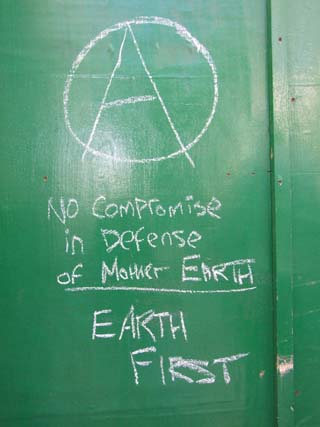
Although for the first half hour or so the police seemed content to watch the protest, scuffles started to develop around the edges. Most seemed to be caused by groups of police grabbing masked demonstrators and attempting to unmask them.
——–
Critical Mass
At 9.30 we were still waiting for more people to join in Bank Junction. We started off at about 10am, with a big sound system and lots of people in costumes.
Our first stop was the Royal Bank of Scotland, RBS, next to Bishopsgate. There we were informed that RBS heavily invest in fossil fuels. RBS has recently given a massive loan to EON, the company behind the coal power station in Kingworth, where the last climate camp took place.
Back on Bishopsgate, we went then to the Deutche Bank, where again the sound system person informed us that this bank has been actively involved in “carbon trading”, which means planting trees to “offset” the excessive carbon emissions that companies in the rich part of the world should not be producing if they were complying with their companies’ signed treaties. This tree-planting has been done in lands of indigenous peoples in the poor part of the world that have been how the land that they need for their own food is used for this business without their being able to do anything about it. We were told that carbon trading is now big business, and that it basically consists of selling the air we breath.
From where we were, across the road, was the Carbon Exchange, which, we’re informed, gives us in the Rich West the ability to use more carbon than we have agreed to use in order to try and stop climate chaos. Big companies in developing countries are said to be making money by selling their carbon credits to big companies in rich countries so that they can use more carbon.
We’re told about a company in South Korea that discovered a product in the 70s that is useful to “decarbonate” the air, but for some mysterious reason it has not made this discovery public, nor used the product, until now, so it has been allowing the South Korean population to be unnecessarily polluted for about 40 years. Now that it is selling this product, this company still makes (10 times?) more money selling carbon trade credits than producing and selling this de-contaminating product.
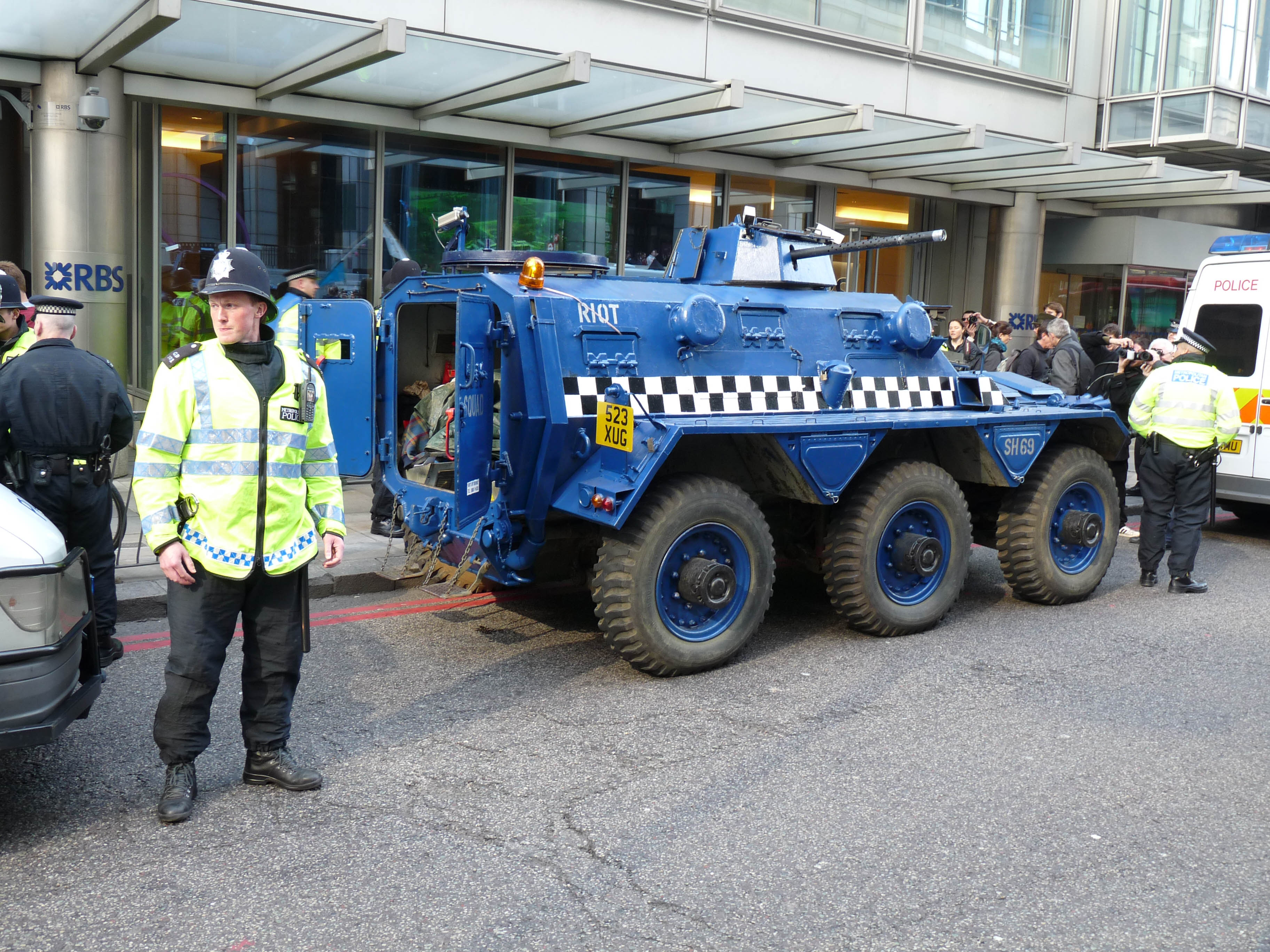 At this point the Space Hijackers took on the microphone to ask us for support because their tank had been “stopped”, surrounded by police. We went there to show our support but the cops didn’t seem very prepared to allow the tank move peacefully.
At this point the Space Hijackers took on the microphone to ask us for support because their tank had been “stopped”, surrounded by police. We went there to show our support but the cops didn’t seem very prepared to allow the tank move peacefully.
At about 10.30 we moved south towards London Bridge. Last stop before crossing the bridge was a spot next to premises of Caterpillar, the company providing home-destroying bulldozers to the Israeli government, and right next to an “Abbey” branch, now property of Grupo Santander, currently in the process of buying most of the Hispanic world and part of the rest, and object of protests and contempt in Spain and Latin America.
From there crossed London Bridge and then Tower Bridge back to the north bank of the river. Next to the tower, we were served with free vegan food reclaimed from the system’s daily waste. There we were joined by the Dancers and then moved on to join the Climate Camp.
In the meantime police had moved on to close all streets that lead to Bank junction to the traffic, and at noon they were preparing to completely cordon off the area, allowing people in but not out, except city workers.
 At 12.15 people were in Bank Junction already penned in and allowed in but not out. In Princess Street there were to lines of cops, separated by about 100 metres. The “outside” line, away from the crowd penned in, was reinforced with three vans crossed.
At 12.15 people were in Bank Junction already penned in and allowed in but not out. In Princess Street there were to lines of cops, separated by about 100 metres. The “outside” line, away from the crowd penned in, was reinforced with three vans crossed.
At 12.30, Queen Victoria Street, on the west side of Bank Junction, it didn’t look like the police had formed a line, but quickly formed at the shout of one of their offices, then moved away from the pen, still forming a line, and pushing people away from the junction, so the police line came to block the access of people coming both from Poultry Street and Queen Victoria Street. The police were wearing bullet proof vests.
In Mansion House Place, a small alley way approaching the Junction from St. Stephen’s Row in the South, police were also forming two lines separated by a few metres, cordoning off the junction and only allowing families and city workers out.
A single line of vans combined with cops blocked the point where King William Street and Lombard Street meet.
A few minutes later horse mounted police were forming the lines instead of policemen on foot.
——–
Photos from the G20 Meltdown, and other protests from today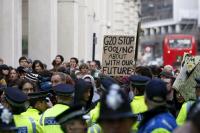
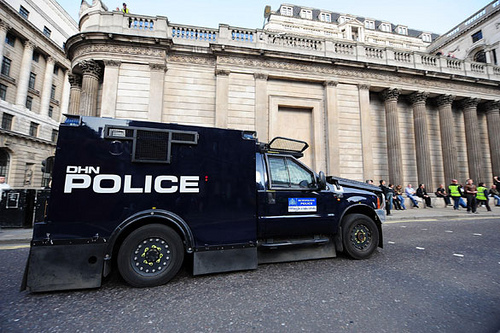 | Other pictures of police APCs: 2 | 3
| Other pictures of police APCs: 2 | 3
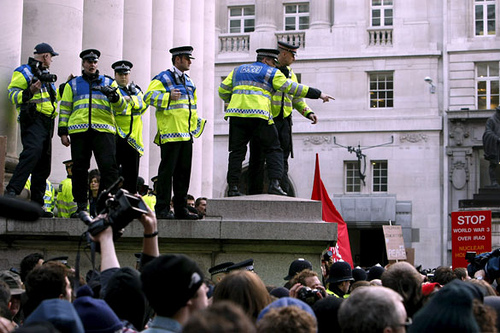


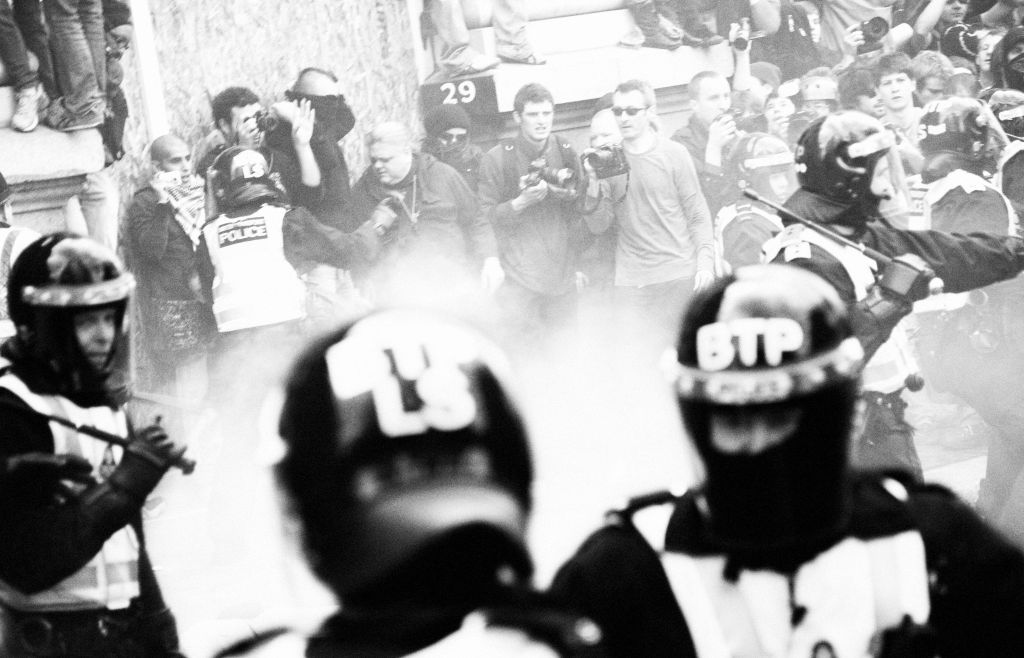
Video of police forced into retreat at G20 Meltdown.
How not to use crowd control barriers when dealing with the police video – also watch police advances & retreats! Tips for how – see the Guide to Public Order Situations.

Link to many other video clips.
——–
Activist tank at Royal Bank of Scotland
The activist group Space Hijackers joined with police to take care of any “bad” demonstrators who might have shown up to anti-G20 protests in the City of London today. At 10:30 this morning they showed up with a CCTV-equipped armoured vehicle in front of the Royal Bank of Scotland and prepared to defend the building.
Police spoilsports refused their help, conducted thorough search of the vehicle, and moved them along. They were later arrested outside News International.
——–
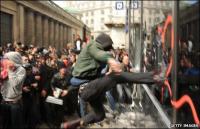 Despite the media’s apocalyptic predictions, the four horsemen (See SchNEWS 667) did at least make it to the Bank of England. Whether this was a good idea or not is open to question. It certainly brought a measure of mayhem to the financial heart of London, which seemed largely closed down for the duration. Our numbers were impressive – given the short notice and the media hype of extreme violence. But tactics adopted gave the Met free rein to place a huge cordon around the entire demo – the so-called kettle.
Despite the media’s apocalyptic predictions, the four horsemen (See SchNEWS 667) did at least make it to the Bank of England. Whether this was a good idea or not is open to question. It certainly brought a measure of mayhem to the financial heart of London, which seemed largely closed down for the duration. Our numbers were impressive – given the short notice and the media hype of extreme violence. But tactics adopted gave the Met free rein to place a huge cordon around the entire demo – the so-called kettle.
As soon as the final Black Horse (ironically the one symbolising land enclosure) arrived, police lines rapidly snapped into place across the streets surrounding the plaza that the bank sits on. Unfortunately – although many did successfully make a break for it – the majority of the crowd, with little idea of what to do (unless they’d read last week’s SchNEWS public order guide obviously) stood around as this manoeuvre was executed. Whilst we know that the protests were organised on very short notice, there seemed to be little aim other than simply getting into the area – there were no bust-cards, and no attempts at crowd co-ordination.
At first most seemed happy to be inside the huge kettle – a few sound-systems were blasting out and there was even a bizarre outburst of contemporary dance in front of the The Royal Exchange. As the hours wore on and the few city types caught in the circle had shown ID and got themselves extracted, it became obvious that if the police had their way no-one was getting out ‘til long after dark. No water, no food, not even a toilet. The reason given? – ‘to prevent a breach of the peace’.
By around half-one the kettle had been truly brought the boil and fighting had broken out along Threadneedle St. A line of police were pushed back by a crowd shouting, “Let us out”. A few bottles were lobbed but even without these the cops were forced to give way to the sheer physical pressure. Alerted by the noise, support streamed over from the other exits to reinforce Threadneedle and push the cops back to the junction with Bartholomew Lane. This left the windows of Royal Bank of Scotland exposed. They were duly smashed, although rioters were outnumbered by photographers by around fifteen to one. However police lines here were too strong to breach.
At around 2.30, the crowd facing a thinner police line across Victoria St suddenly surged forward and by sheer weight of numbers pushed their way through. One of the shovers told SchNEWS, “It was amazing – we were resigned to being in the kettle until midnight but the lines broke right in front of me and confused police were shouting asking each other, ‘What’s the plan?’”. Despite the rapid deployment of riot cops, possibly up to a thousand people escaped at this point. Soon the windows of HSBC on Cheapside had gone in.
SchNEWS has heard reports that others managed to sneak or blag their way out over the next few hours but during the afternoon the noose was gradually tightened with baton charges. Eyewitnesses reported a sense of panic developing inside the pen. People were not allowed out until after 8pm and only then after being photographed.
One man, Ian Tomlinson is known to have died inside the cordon. SchNEWS has heard conflicting reports as to whether he was struck by police. Perhaps a coroners inquiry into his death will expose police tactics to public glare (unless they invoke their handy new powers to keep it all secret of course).
This report and others at http://www.schnews.org.uk/archive/news671.htm
——–
——–
2nd April
Timeline
——–
Bank of England vigil underway for the man who died at yesterday‘s G20 Meltdown protest.
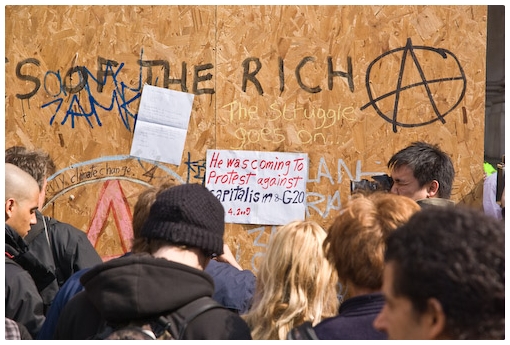
Around 200 protesters have gathered in the City, on the steps of the Old Exchange by the Bank of England. Their presence represents a spontaneous protest in solidarity for the man who died while kettled at G20 Meltdown yesterday.
No details of the man’s death have been released. All that’s known is he was around 30-years-old and died while kettled with thousands of others outside the Bank of England.
Demonstrators are demanding answers and an independent inquiry into the man’s death. A wall of condolences for the man who died as sprung up. A minute silence was held also.
Police are operating an on off kettle policy. This appears to be a method of encouraging people to leave while they can.
The mood over all is calm. There have been waves of chanting: SHAME SHAME SHAME ON YOU and WHO’S STREETS? OUR STREETS! to the 200-odd police drafted in to “keep the peace.”
While some protesters have left, many others continue to arrive. Some line the pavements outside the Bank of England. Police are now attempting to move these people on.
—
Interview with two eyewitnesses of the events preceding the death of Ian Tomlinson, the man who died during anti G20 protests in the City of London on the 1st of April.
Witnesses Statement: Death at G20
PRESS RELEASE
FOR IMMEDIATE RELEASE
Various participants in the City of London demonstrations on April 1st have come forward as witnesses to the collapse of a man later identified by authorities as Ian Tomlinson. Four different university students witnessed the collapse of Mr. Tomlinson. “He stumbled towards us from the direction of police and protesters and collapsed,” said Peter Apps. “I saw a demonstrator who was a first aider attend to the person who had collapsed. The man was late 40s, had tattoos on his hands, and was wearing a Millwall shirt.”
While the first aider was helping the man, another demonstrator with a megaphone was calling the police over so that they could help.
Natalie Langford, a student at Queen Mary, said “there was a police charge. A lot of people ran in our direction. The woman giving first aid stood in the path of the crowd.” The running people, seeing a guy on the ground, went around them.
Another demonstrator had already called 999 and was getting medical advice from the ambulance dispatcher. “Four police with two police medics came. They told her [the first aider] to ‘move along’.”, said Peter Apps. “Then they pushed her forcibly away from him. They refused to listen to her [the first aider] when she tried to explain his condition.”
The first aider, who did not wish to be named, said “The police surrounded the collapsed man. I was standing with the person who’d called 999. The ambulance dispatcher wanted to talk to the police, the phone was being held out to them, but the police refused.”
Another witness, Elias Stoakes, added “we didn’t see them [the police] perform CPR.”
Other people who had tried to stay with the collapsed man were also pushed away.
All of the witnesses deny the allegation that many missiles were thrown.
According to Peter Apps, “one bottle was thrown, but it didn’t come close to the police. Nothing was thrown afterwards as other demonstrators told the person to stop. The person who threw the bottle probably didn’t realize that someone was behind the ring of police.” All the witnesses said that the demonstrators were concerned for the well-being of the collapsed man once they realized that there was an injured person.
Natalie Langford said “when the ambulance arrived the protesters got straight out of the way.”
These witnesses are happy to give media statements.
They can be contacted through this press liaison email: g20witnesses@gmail.com
——–
Police Raid at Earl Street G20 Convergence Centre
As people were organising to leave the convergence space at mid-day today police raided. 30-40 people attempted to protect the space by blockading the main doors. We then congregated on the top floor and sat in a circle with our arms in the air to show the police that we were not violent. However, the police met us with a taser gun, full riot gear and proceeded to make us lie face down with our hands on the floor.
We believe two people were arrested, although we are unsure what they have been charged with. One has been taken to hospital following an injury. The rest were searched, handcuffed and had names, DOB, addresses and photos taken.
If anyone has more information please contact legal support urgently: legal@climatecamp.org.uk
Searches/details illegally demanded before raid begins here.
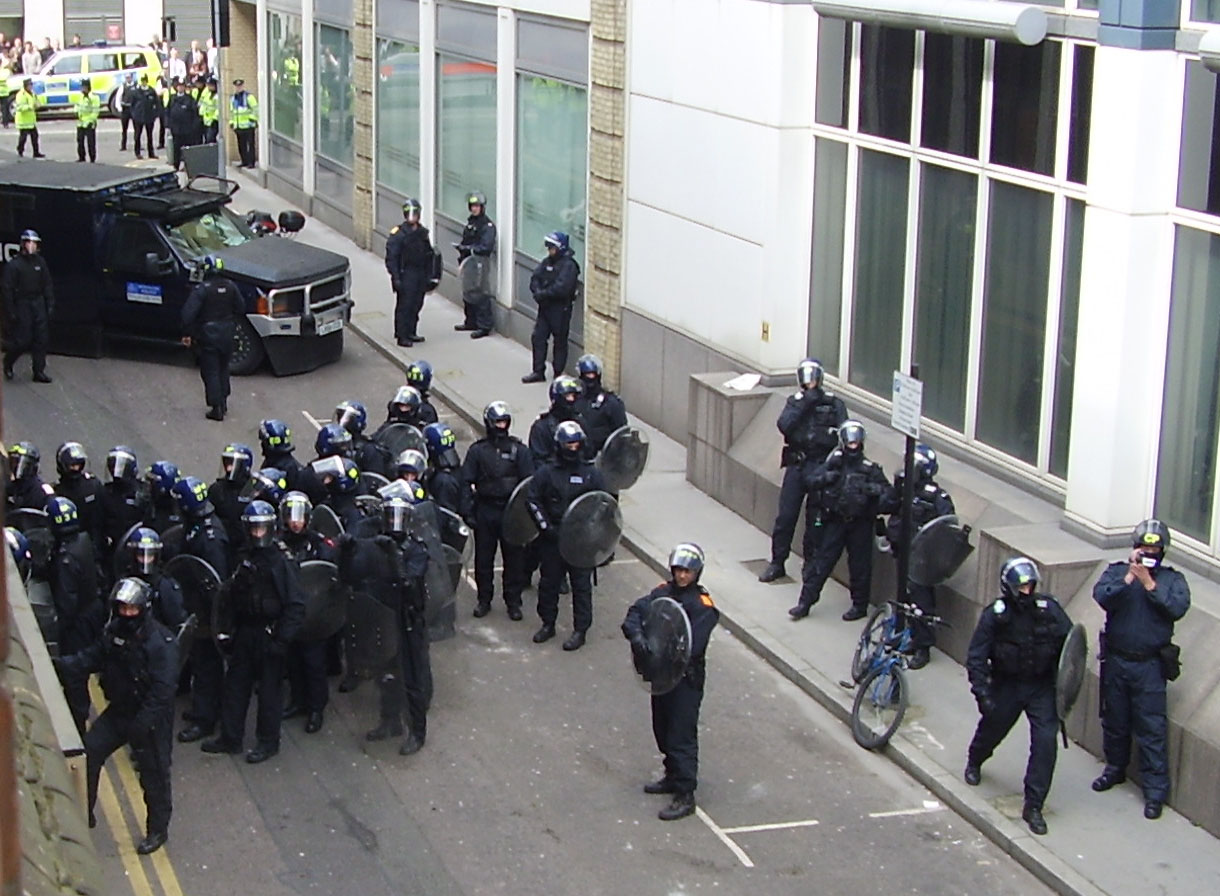 Convergence centre eviction full timeline here.
Convergence centre eviction full timeline here.
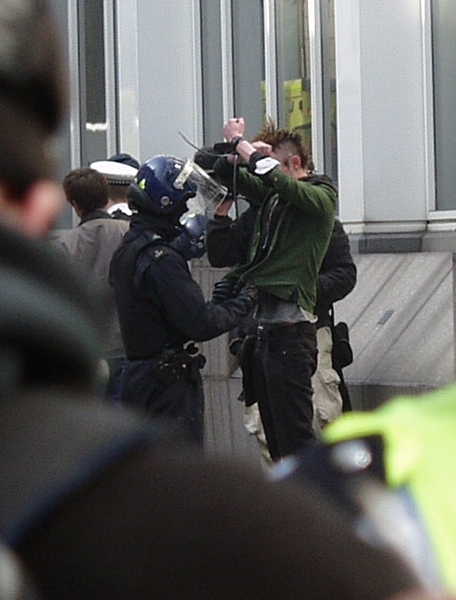
——
Police attack Rampart Social Centre
At around 12:30 this afternoon, 30-50 police arrived at the Rampart, an activist social centre in Whitechapel, East London. A formerly derelict building which had been empty for years, Rampart was occupied by activists and turned into a social and cultural venue more than four years ago.
When the police arrived, someone went outside to speak to them, asking them if they were going to search the place and telling them that if they had a warrant they could just knock on the door. The police told him not to worry.
A few minutes later riot police in black uniforms, wearing balaclavas came through a downstairs window, the door to the roof and a door to an adjoining building. The police broke down the doors and stormed in with drawn tasers, screaming at everyone to get down on the ground, jumping on them and handcuffing them. They had a TV crew with them when breaking in through the door. They were insulting people and saying things like “one of you croaked last night”, trying to provoke a bad reaction from people.
They then demanded identification from everyone and checked IDs against what appeared to be a list of specific people. There were 2 or 3 arrests. The remaining people were then let go.
Right now it’s calm, however people are a bit shaken after the experience. The cops have left the neighbourhood.
——
Spiderman on bail after G20 Lloyds Climate Demo
Alain Robert, otherwise known as ‘Spiderman’ for his daring free climbs of urban buildings was arrested earlier today for climbing the Lloyds building in London in a G20 climate change protest.
Unfurling a banner that advertised the campaign onehundredmonths.org (which says we have little under 92 months left to prevent catastrophic climate change), he climbed down from the 9th floor and was arrested by police for aggravated trespass.
——–
——–
Other interesting articles from other days:
——
There have been 122 arrests related to the G20, including 86 on Wednesday and 32 on Thursday, police said.
——
Police ask train staff to spy on G20 protesters
——
One-man G20 protest on 28th March 2009
——
Spoof Financial Times hits London streets
10000 copies of a spoof Financial Times were distributed in London today.
“Set in 2020, the 12-page paper revealed how action in 2009 reined in climate change, saving billions from extinction. Carbon rationing didn’t kill us, it explained, despite the inconvenience to multinational companies. But we couldn’t have endless growth with finite resources. Editors even apologised for suggesting otherwise.”
The paper is a full-colour replica of the iconic pink broadsheet including national and international pages and editorials and comment, poking fun at FT columnists. It was funded by donations on the Internet, and given away for free by volunteers. Tens of thousands of copies were printed – almost as many as the FT sells here daily.
Download as a PDF file
——
International Solidarity – Aotearoa/New Zealand | Finland
